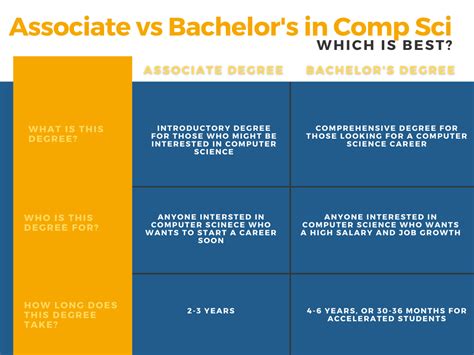Introduction

When embarking on a higher education journey, individuals often face the decision between pursuing an associate’s or bachelor’s degree. Both options offer distinct advantages and disadvantages that warrant careful consideration. This comprehensive guide will delve into the key differences between these degrees, empowering you to make an informed choice that aligns with your career aspirations and personal goals.
1. Types of Associate’s and Bachelor’s Degrees
Associate’s Degrees
- Associate of Arts (A.A.): Focuses on liberal arts and general education coursework.
- Associate of Applied Science (A.A.S.): Prepares students for specific occupations or technical fields.
- Associate of Occupational Science (A.O.S.): Provides specialized training in healthcare, business, or technical areas.
Bachelor’s Degrees
- Bachelor of Arts (B.A.): Emphasizes liberal arts and humanities.
- Bachelor of Science (B.S.): Focuses on science, technology, engineering, and mathematics (STEM).
- Bachelor of Applied Science (B.A.S.): Combines theory and practical application in specific fields like nursing, education, or business.
2. Length and Cost of Education
Associate’s Degrees
- Typically completed in 2 years (60 credit hours).
- Average cost: $16,000 – $20,000 for in-state tuition.
Bachelor’s Degrees
- Typically completed in 4 years (120 credit hours).
- Average cost: $25,000 – $50,000 per year for in-state tuition.
3. Career Prospects and Earning Potential
Associate’s Degrees
- Prepare individuals for entry-level positions in various fields.
- Graduates earn an average of $45,000 annually.
Bachelor’s Degrees
- Provide advanced knowledge and skills for mid-level or managerial positions.
- Graduates earn an average of $60,000 annually.
4. Advantages and Disadvantages
Associates Degrees
Advantages:
- Shorter duration and lower cost.
- Provide entry-level job opportunities.
- Can be a stepping stone to a bachelor’s degree.
Disadvantages:
- Limited career advancement opportunities.
- Lower earning potential compared to bachelor’s degree holders.
Bachelor’s Degrees
Advantages:
- Higher earning potential and career advancement opportunities.
- Provide a broader foundation of knowledge and skills.
- Offer more specialized training and research opportunities.
Disadvantages:
- Longer duration and higher cost.
- More competitive job market.
5. Deciding Between an Associate’s and Bachelor’s Degree
Consider the following factors:
- Career goals and interests.
- Job market demand for specific degrees.
- Financial situation and long-term aspirations.
- Time and resources available for education.
Tips and Tricks
- Research different degree programs at various institutions.
- Attend career fairs and speak with professionals in your desired field.
- Explore online resources and educational advisors for guidance.
- Consider your personal circumstances and preferences.
Common Mistakes to Avoid
- Choosing a degree solely based on cost or duration without considering career goals.
- Underestimating the financial commitment and time required for a bachelor’s degree.
- Dismissing the value of an associate’s degree as a stepping stone to higher education.
- Not researching the job market and career opportunities before deciding on a degree program.
Conclusion
The choice between an associate’s or bachelor’s degree is a significant decision with lifelong implications. By carefully weighing the advantages, disadvantages, and your personal circumstances, you can make an informed choice that aligns with your career aspirations and sets you on a path to success. Remember that education is an investment that will pay dividends throughout your lifetime.
